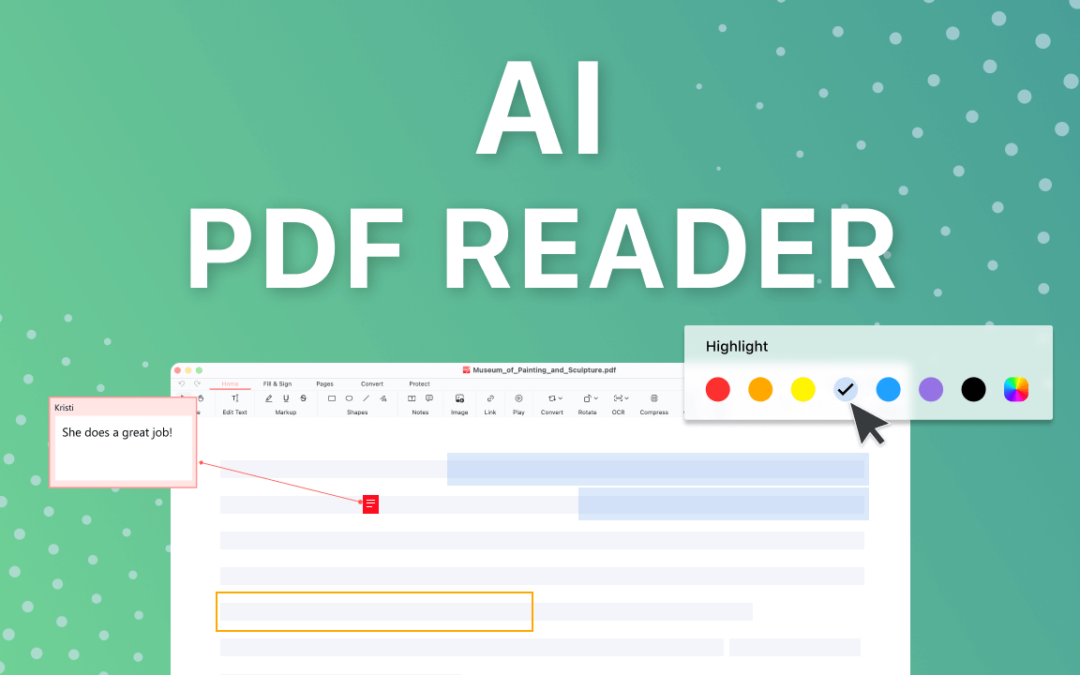AI PDF readers utilize artificial intelligence technology, including machine learning and neural networks, to greatly enhance the capabilities and functionality of traditional PDF software.
They can accurately interpret both text and images contained within digital documents, enabling advanced predictive search, automation, personalization as well as other smart features aimed at streamlining workflows and unlocking insights.
In this article, we’ll discuss why AI-powered PDF readers provide robust solutions to efficiently manage, access, comprehend, and leverage valuable data locked in files at scale.
Benefits of AI PDF Readers
Improved text recognition
An ai pdf reader utilizes advanced optical character recognition capabilities combined with natural language processing technology to thoroughly analyze text found within documents down to the semantic level.

This facilitates drastically more accurate and contextual search compared to the basic keyword matching limitations of traditional PDF readers. By interpreting content meaning, structure, and intent, AI allows users to discover vital information within documents using intuitive search methods.
Advanced search capabilities
Incorporating powerful machine learning algorithms enables AI PDF readers to rapidly index documents and surface valuable insights from vast amounts of unstructured data quickly using predictive search language interfaces.
It mitigates traditionally tedious manual skimming of PDF files page-by-page to locate details, vastly improving productivity and research. Additionally, personalization algorithms provide users with customized recommendations of related documents based on individual activity over time.
Enhanced organization and annotation features
Intelligent tagging of document contents by type, entity, topic, and other attributes assisted by machine learning aids in content curation across document repositories. AI readers also automatically handle cross-referencing across related documents to link key concepts. Dynamic bookmarking of custom tags evolves over time per user patterns, replacing static manual bookmarking.
Furthermore, embedded smart annotation tools can auto-highlight or extract only key data points from documents based on user preferences and usage needs in order to enhance reports or summaries.
Comparison with Traditional PDF Readers
Speed and accuracy
Utilizing advanced pattern recognition capabilities, AI PDF readers empower high-precision searches, near-perfect text accuracy rates after multiple learning iterations, rapid processing of even significantly large file volumes, and predictive recommendations.
These key advantages aim to eliminate common frustrations faced when using traditional software lacking any intelligent features by optimizing for productivity.
Customization and personalization
Informed by continually analyzing vast volumes of individual user activity data, AI PDF readers actively study habits and preferences at scale. This allows appropriately customizing experiences over time based on relevance to each user for a more tailored feel.
Traditional readers lack any personalization capabilities whatsoever, so any customization requires intensive manual setup on the user end to optimize. AI powered software automates this otherwise tedious process by handling adjustments under the surface.
Security and privacy features
Due to increased complexity, AI-centric software necessitates more proactive vigilance from vendors regarding potential data and privacy vulnerabilities compared to legacy solutions lacking intelligence layers.
However, innovations in multi-layered encryption, access controls, authorization frameworks, and hardened network architectures all help mitigate risks introduced by AI through advanced security infrastructure investments.
Cost-Effectiveness
Initial investment vs. long-term savings
Considering cumulative costs spread over time, while premium annual subscriptions for AI PDF reader plans currently exceed one-time purchase fees for basic reader software, integrating intelligent automation generates sizable downstream productivity and time savings when used regularly over months and years of duration. When factoring the long-term horizon, AI readers present compelling value that more than justifies upfront investments.
Value for money in terms of features and performance
When comparing available features, processing capacities, and overall performance benchmarks, AI PDF reader solution pricing generally aligns appropriately with the significant expansions in functionality offered over basic reader tools.
Users gain access to advanced capabilities like predictive search, personalized recommendations, and automated tagging that add substantial value. So the costs typically deliver proportionate added value. Furthermore, investments made even in 2024 supply future-proofed technology positioned to scale additional functionality as AI solutions mature.
User Experience and Satisfaction
Ease of use and learning curve
The complexity underlying AI readers’ advanced functionality can intuitively establish assumptions of equally steep learning curves to leverage features.
However, thoughtful user experience design including embedded support resources like step-by-step guidance combined with innovations in predictive search actually simplify software usage – overcoming common adoption barriers faced with traditional tools lacking intuitive interfaces. Simplified navigation and built-in educational tools alleviate friction.
Feedback from users and reviews
Surveys of early user experiences and reviews of the top AI PDF readers highlight very high satisfaction metrics so far, especially praising the usability improvements when comparing manual approaches of traditional file readers.
The embedded intelligent functionality receives particularly positive reception, with users citing excellent experiences around predictive search and personalized recommendations that save vast time. This serves to validate purchasing decisions as strong investments in productivity.
Customer support and updates
Between robust customer support resources like 24/7 help desks and chatbots to reliable, consistent software update deployment cycles focused on refining AI model accuracy, user experiences and satisfaction levels continue building over time as needs evolve. This protects investments in the solutions by supplying world-class ongoing assistance and education.
Future Trends and Development of AI PDF Readers
Integration with other technologies
As artificial intelligence permeates broader information workplace technology stacks and workflows, AI PDF readers will likely pursue tighter integration with complementary solutions like centralized data platforms, analytics dashboards, and process automation software. Connecting previously siloed systems can unlock additional productivity gains through interconnected data flows.
Potential advancements and innovations
Continued exponential cloud computing infrastructure scaling to handle surging data combined with specialized neural networks reaching new sophistication thresholds signal strong opportunity to enhance existing functionality within AI PDF readers even further.
Expected innovations over near-term horizons involve multilingual content interpretation, context-aware recommendations, and streamlined accessibility features.
Impact of AI on the future of PDF reading
Based on rising adoption metrics so far, AI-enabled PDF readers appear well poised to displace legacy tools almost entirely over the next 5-10 years.
As global data complexity and file volumes accelerate, the embedded intelligent functionality will likely become an imperative baseline requirement for unlocking value. AI promises to transform digital document comprehension amidst overwhelming growth.
Conclusion
AI PDF reader solutions deliver significant advantages around productivity gains, personalization, and future-proofed positioning that substantially outweigh costs.
With capabilities far beyond basic readers and considerable long-term upside, 2024 makes for an opportune strategic timing to invest and adopt AI readers. And as intelligent functionality becomes ingrained into workflows, these tools secure indispensable roles in document management.

